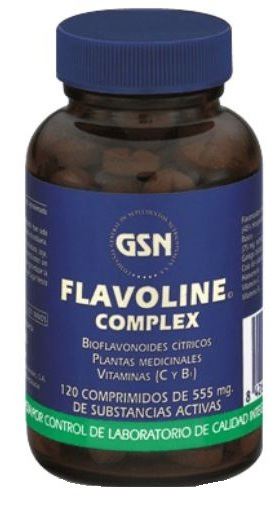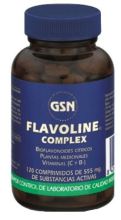GSN Flavoline 120Comp. 555 Mg.
GSN


Description
Bioflavonoids , also known as P vitamins, are naturally occurring compounds that provide the yellow-orange color to citrus fruits.
Among the medicinal plants that offer the best synergy with flavonoids, the Rusco, Ginkgo, Hamamelis and Horsetail stand out.
FLAVOLINE COMPLEX is a preparation that contains:
Citrus bioflavonoids. They are natural substances extracted from the peel of citrus fruits and whose basic constituent is phenylchroman.
Butcher's broom, rhizome (Ruscus aculeatus L.).
It is a plant that finds its habitat in shady lowland and mountainous terrain, especially in beech forests of the Iberian Peninsula.
Ginkgo, leaves (Ginkgo biloba L.).
The only living representative of the Ginkgoaceae family, it is a tree about 30 meters high, native to China. Its leaves are long petiolate and bilobed.
Horsetail, sterile stems (Equisetum arvense L.).
It is a plant species that finds its habitat in sandy and humid soils of Europe and America. Its sterile stems are green, striated and highly branched.
Hamamelis leaves (Hamamelis virginiana L.).
It is a plant native to North America. It is a shrub with alternate leaves and fibrous bark that can reach up to 5 meters in height.
Vitamins C and B1.
They are essential nutrients that must be provided daily with the diet.
They present a synergistic action with bioflavonoids and the other components of the formula.
This product combines four plant species with vitamins and flavonoids to provide the following active ingredients:
Among the bioflavonoids that are extracted from the peel of citrus fruits, hesperidin, neohesperidin and naringin stand out.
The Rusco rhizome is rich in steroidal saponins.
Its main glycosides are derived from ruscogenin and neorruscogenin.
The active principles of Ginkgo are found in its leaves, among them, the ginkgoflavonoids and terpenes stand out: bilobalide and ginkgolides.
Horsetail is rich in inorganic compounds (salts of silica, potassium, magnesium and aluminum).
In addition, it contains flavonoids, saponosides and tannins.
Hamamelis leaves contain 3-10% gallic tannins and traces of cathekic tannins.
It also has leucoanthocyanins and quercetin glycosides.
Among the medicinal plants that offer the best synergy with flavonoids, the Rusco, Ginkgo, Hamamelis and Horsetail stand out.
FLAVOLINE COMPLEX is a preparation that contains:
Citrus bioflavonoids. They are natural substances extracted from the peel of citrus fruits and whose basic constituent is phenylchroman.
Butcher's broom, rhizome (Ruscus aculeatus L.).
It is a plant that finds its habitat in shady lowland and mountainous terrain, especially in beech forests of the Iberian Peninsula.
Ginkgo, leaves (Ginkgo biloba L.).
The only living representative of the Ginkgoaceae family, it is a tree about 30 meters high, native to China. Its leaves are long petiolate and bilobed.
Horsetail, sterile stems (Equisetum arvense L.).
It is a plant species that finds its habitat in sandy and humid soils of Europe and America. Its sterile stems are green, striated and highly branched.
Hamamelis leaves (Hamamelis virginiana L.).
It is a plant native to North America. It is a shrub with alternate leaves and fibrous bark that can reach up to 5 meters in height.
Vitamins C and B1.
They are essential nutrients that must be provided daily with the diet.
They present a synergistic action with bioflavonoids and the other components of the formula.
This product combines four plant species with vitamins and flavonoids to provide the following active ingredients:
Among the bioflavonoids that are extracted from the peel of citrus fruits, hesperidin, neohesperidin and naringin stand out.
The Rusco rhizome is rich in steroidal saponins.
Its main glycosides are derived from ruscogenin and neorruscogenin.
The active principles of Ginkgo are found in its leaves, among them, the ginkgoflavonoids and terpenes stand out: bilobalide and ginkgolides.
Horsetail is rich in inorganic compounds (salts of silica, potassium, magnesium and aluminum).
In addition, it contains flavonoids, saponosides and tannins.
Hamamelis leaves contain 3-10% gallic tannins and traces of cathekic tannins.
It also has leucoanthocyanins and quercetin glycosides.
Features
- Reference8426609040032
- BrandGSN
Customer Reviews
GSN Flavoline 120Comp. 555 Mg.

